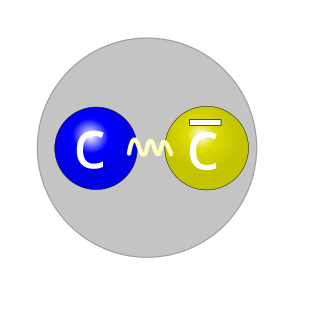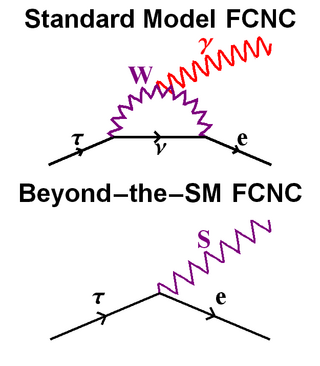Related Research Articles

The charm quark, charmed quark, or c quark is an elementary particle found in composite subatomic particles called hadrons such as the J/psi meson and the charmed baryons created in particle accelerator collisions. Several bosons, including the W and Z bosons and the Higgs boson, can decay into charm quarks. All charm quarks carry charm, a quantum number. This second generation is the third-most-massive quark with a mass of 1.27±0.02 GeV/c2 as measured in 2022 and a charge of +2/3 e.

A pentaquark is a human-made subatomic particle, consisting of four quarks and one antiquark bound together; they are not known to occur naturally, or exist outside of experiments specifically carried out to create them.
In physical cosmology, baryogenesis is the physical process that is hypothesized to have taken place during the early universe to produce baryonic asymmetry, i.e. the imbalance of matter (baryons) and antimatter (antibaryons) in the observed universe.

In particle physics, a tetraquark is an exotic meson composed of four valence quarks. A tetraquark state has long been suspected to be allowed by quantum chromodynamics, the modern theory of strong interactions. A tetraquark state is an example of an exotic hadron which lies outside the conventional quark model classification. A number of different types of tetraquark have been observed.

The
J/ψ
(J/psi) meson is a subatomic particle, a flavor-neutral meson consisting of a charm quark and a charm antiquark. Mesons formed by a bound state of a charm quark and a charm anti-quark are generally known as "charmonium" or psions. The
J/ψ
is the most common form of charmonium, due to its spin of 1 and its low rest mass. The
J/ψ
has a rest mass of 3.0969 GeV/c2, just above that of the
η
c, and a mean lifetime of 7.2×10−21 s. This lifetime was about a thousand times longer than expected.

The LHCb experiment is a particle physics detector experiment collecting data at the Large Hadron Collider at CERN. LHCb is a specialized b-physics experiment, designed primarily to measure the parameters of CP violation in the interactions of b-hadrons. Such studies can help to explain the matter-antimatter asymmetry of the Universe. The detector is also able to perform measurements of production cross sections, exotic hadron spectroscopy, charm physics and electroweak physics in the forward region. The LHCb collaboration, who built, operate and analyse data from the experiment, is composed of approximately 1650 people from 98 scientific institutes, representing 22 countries. Vincenzo Vagnoni succeeded on July 1, 2023 as spokesperson for the collaboration from Chris Parkes. The experiment is located at point 8 on the LHC tunnel close to Ferney-Voltaire, France just over the border from Geneva. The (small) MoEDAL experiment shares the same cavern.

In particle physics, quarkonium is a flavorless meson whose constituents are a heavy quark and its own antiquark, making it both a neutral particle and its own antiparticle. The name "quarkonium" is analogous to positronium, the bound state of electron and anti-electron. The particles are short-lived due to matter-antimatter annihilation.

Exotic hadrons are subatomic particles composed of quarks and gluons, but which – unlike "well-known" hadrons such as protons, neutrons and mesons – consist of more than three valence quarks. By contrast, "ordinary" hadrons contain just two or three quarks. Hadrons with explicit valence gluon content would also be considered exotic. In theory, there is no limit on the number of quarks in a hadron, as long as the hadron's color charge is white, or color-neutral.

In particle physics, flavor-changing neutral currents or flavour-changing neutral currents (FCNCs) are hypothetical interactions that change the flavor of a fermion without altering its electric charge.

The Belle experiment was a particle physics experiment conducted by the Belle Collaboration, an international collaboration of more than 400 physicists and engineers, at the High Energy Accelerator Research Organisation (KEK) in Tsukuba, Ibaraki Prefecture, Japan. The experiment ran from 1999 to 2010.
CLEO was a general purpose particle detector at the Cornell Electron Storage Ring (CESR), and the name of the collaboration of physicists who operated the detector. The name CLEO is not an acronym; it is short for Cleopatra and was chosen to go with CESR. CESR was a particle accelerator designed to collide electrons and positrons at a center-of-mass energy of approximately 10 GeV. The energy of the accelerator was chosen before the first three bottom quark Upsilon resonances were discovered between 9.4 GeV and 10.4 GeV in 1977. The fourth Υ resonance, the Υ(4S), was slightly above the threshold for, and therefore ideal for the study of, B meson production.
The
B
s meson is a meson composed of a bottom antiquark and a strange quark. Its antiparticle is the
B
s meson, composed of a bottom quark and a strange antiquark.
The X(3872) is an exotic meson candidate with a mass of 3871.68 MeV/c2 which does not fit into the quark model because of its quantum numbers. It was first discovered in 2003 by the Belle experiment in Japan and later confirmed by several other experimental collaborations. Several theories have been proposed for its nature, such as a mesonic molecule or a diquark-antidiquark pair (tetraquark).
Z(4430) is a mesonic resonance discovered by the Belle experiment. It has a mass of 4430 MeV/c2. The resonant nature of the peak has been confirmed by the LHCb experiment with a significance of at least 13.9 σ. The particle is charged and is thought to have a quark content of
c
c
d
u
, making it a tetraquark candidate. It has the spin-parity quantum numbers JP = 1+.
In particle physics, B mesons are mesons composed of a bottom antiquark and either an up, down, strange or charm quark. The combination of a bottom antiquark and a top quark is not thought to be possible because of the top quark's short lifetime. The combination of a bottom antiquark and a bottom quark is not a B meson, but rather bottomonium, which is something else entirely.
The D mesons are the lightest particle containing charm quarks. They are often studied to gain knowledge on the weak interaction. The strange D mesons (Ds) were called "F mesons" prior to 1986.
The Y(4260) is an anomalous particle with an energy of 4260 MeV which does not appear to fit into the quark model. It was discovered by the BaBar experiment at Stanford University for the Department of Energy in California and later confirmed by several other experimental collaborations. It being a Charmonium state is unlikely because the Y(4260) is heavier than the threshold for production of two D mesons, yet sits, surprisingly in a dip in the production rate for pairs of D's. It is a possibility that it is a hybrid—a predicted but not-yet-seen type of particle, where a gluon is actually a permanent part of the makeup of the particle, instead of just an ephemeral messenger keeping the quarks bound together.
The Zc(3900) is a hadron, a type of subatomic particle made of quarks, believed to be the first tetraquark that has been observed experimentally. The discovery was made in 2013 by two independent research groups: one using the BES III detector at the Chinese Beijing Electron Positron Collider, the other being part of the Belle experiment group at the Japanese KEK particle physics laboratory.

Kam-Biu Luk is a professor of physics, with a focus on particle physics, at UC Berkeley and a senior faculty scientist in the Lawrence Berkeley National Laboratory's physics division. Luk has conducted research on neutrino oscillation and CP violation. Luk and his collaborator Yifang Wang were awarded the 2014 Panofsky Prize "for their leadership of the Daya Bay experiment, which produced the first definitive measurement of θ13 angle of the neutrino mixing matrix." His work on neutrino oscillation also received 2016 Breakthrough Prize in Fundamental Physics shared with other teams. He also received a Doctor of Science honoris causa from the Hong Kong University of Science and Technology in 2016. Luk is a fellow of the American Physical Society, and the American Academy of Arts and Sciences.

Bradley Cox is an American physicist, academic and researcher. He is a Professor of Physics and the founder of the High Energy Physics Group at the University of Virginia.
References
- ↑ "KNU graduate Prof. Sookyung Choi wins the 2017 Hoam Prize". KNU. Retrieved 2019-01-14.
- ↑ Choi, Soo Kyung; Kim, Jihn E.; Lee, Taeyeon; Song, H. S. (1984-05-01). "Polarization of recoil-electron beam in high-energy M\o{}ller and Bhabha scattering". Physical Review D. 29 (9): 1909–1917. Bibcode:1984PhRvD..29.1909C. doi:10.1103/PhysRevD.29.1909.
- 1 2 "Unusual Subatomic Particle Discovered". www.vtnews.vt.edu. Retrieved 2019-01-14.
- ↑ Abe, K.; et al. (Belle Collaboration) (2001-08-14). "Observation of Large $\mathit{CP}$ Violation in the Neutral $\mathit{B}$ Meson System". Physical Review Letters. 87 (9): 091802. arXiv: hep-ex/0107061 . Bibcode:2001PhRvL..87i1802A. doi:10.1103/PhysRevLett.87.091802. PMID 11531561. S2CID 3197654.
- ↑ Abe, K.; et al. (Belle Collaboration) (2002-09-16). "Observation of Double $c\overline{c}$ Production in ${e}^{+}{e}^{\ensuremath{-}}$ Annihilation at $\sqrt{s}\ensuremath{\approx}10.6\text{ }\text{ }\mathrm{G}\mathrm{e}\mathrm{V}$". Physical Review Letters. 89 (14): 142001. arXiv: hep-ex/0205104 . doi:10.1103/PhysRevLett.89.142001. PMID 12366036.
- ↑ "Double ccbar Production at Belle" (PDF). www.qwg.to.infn.it. Retrieved 2019-01-14.
- ↑ "Scientists find mystery particle". 2003-11-18. Retrieved 2019-01-14.
- ↑ "YouTube". www.youtube.com. Retrieved 2019-01-14.
- ↑ Choi, S.-K.; et al. (Belle Collaboration) (2003-12-23). "Observation of a narrow charmonium-like state in exclusive B+ -> K+ pi+pi- J/psi decays". Physical Review Letters. 91 (26): 262001. arXiv: hep-ex/0309032 . Bibcode:2003PhRvL..91z2001C. doi:10.1103/PhysRevLett.91.262001. ISSN 0031-9007. PMID 14754041. S2CID 1017547.
- ↑ Choi, S.-K.; et al. (Belle Collaboration) (2005-05-01). "Observation of a Near-Threshold ωJ/ψ Mass Enhancement in Exclusive B→KωJ/ψ Decays". Physical Review Letters. 94 (18): 182002. arXiv: hep-ex/0408126 . Bibcode:2005PhRvL..94r2002C. doi:10.1103/PhysRevLett.94.182002. ISSN 0031-9007. PMID 15904362. S2CID 2307199.
- ↑ Choi, S.-K.; et al. (Belle Collaboration) (2008-04-08). "Observation of a Resonancelike Structure in the π+−ψ′ Mass Distribution in Exclusive B→Kπ+−ψ′ Decays". Physical Review Letters. 100 (14): 142001. arXiv: 0708.1790 . Bibcode:2008PhRvL.100n2001C. doi:10.1103/PhysRevLett.100.142001. PMID 18518023. S2CID 119138620.
- ↑ CHOI, Sookyung (2010-06-07). "Charmonium-like particles at Belle". Proceedings of European Physical Society Europhysics Conference on High Energy Physics — PoS(EPS-HEP 2009). p. 053. doi: 10.22323/1.084.0053 .
- ↑ Choi, Sookyung (2011-01-29). "Spectroscopy results from Belle". arXiv: 1101.5691 [hep-ex].
- ↑ Sookyung, Choi (2014-03-07). Hadron and Quarkmonium Exotica. OCLC 878584784.
- ↑ "Physics Nobel for matter-antimatter difference and symmetry breaking". symmetry magazine. 7 October 2008. Retrieved 2019-01-14.
- ↑ Brumfiel, Geoff (2008-10-07). "Nobel Prize in Physics for symmetry breakdown". Nature. doi:10.1038/news.2008.1155. ISSN 0028-0836.
- ↑ "CP Violation in B Decays: Measuring sin(2beta)". www-public.slac.stanford.edu. Retrieved 2019-01-14.
- ↑ Libby, Jim (2014-12-13). "Direct CP violation in hadronic B decays". arXiv: 1412.4269 [hep-ex].
- ↑ TAKASAKI, Fumihiko (2012-07-25). "The discovery of CP violation in B-meson decays". Proceedings of the Japan Academy. Series B, Physical and Biological Sciences. 88 (7): 283–298. Bibcode:2012PJAB...88..283T. doi:10.2183/pjab.88.283. ISSN 0386-2208. PMC 3422684 . PMID 22850723.
- ↑ Levy, S. (2004-06-16). "Observation of CP Violation in the Neutral B Meson System" (PDF). doi:10.2172/826982. OSTI 826982.
{{cite journal}}: Cite journal requires|journal=(help) - ↑ Sahoo, H.; et al. (Belle Collaboration) (2011-09-22). "Measurements of CP Violation in B Meson decays at Belle". arXiv: 1109.4780 [hep-ex].
- ↑ Kou, E.; Urquijo, P.; et al. (Belle Collaboration) (2019). "The Belle II Physics Book". Progress of Theoretical and Experimental Physics. 2019 (12). arXiv: 1808.10567 . doi:10.1093/ptep/ptz106.
- ↑ "ICHEP2018 SEOUL". www.ichep2018.org. Retrieved 2019-01-14.
- ↑ "Prize winners-By years - THE HO-AM PRIZE". Samsung Foundation. Retrieved 2019-01-14.
- ↑ "Samsung family skips annual Ho Am award event". www.theinvestor.co.kr. Retrieved 2019-01-14.
- ↑ "BELLE HOME PAGE". belle.kek.jp. Retrieved 2019-01-14.
- ↑ "7 Award-Winning Female Scientists". Asian Scientist Magazine | Science, technology and medical news updates from Asia. 2018-02-09. Retrieved 2019-01-14.